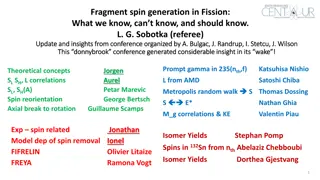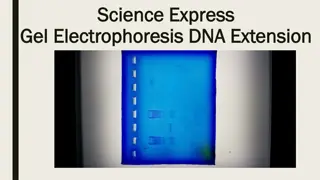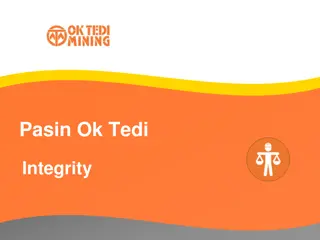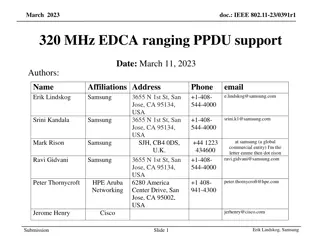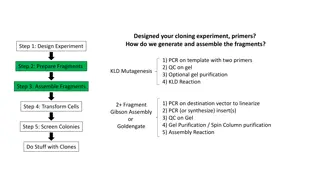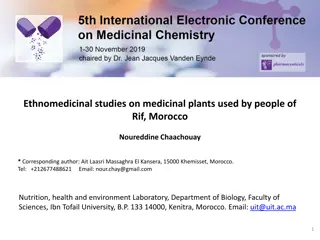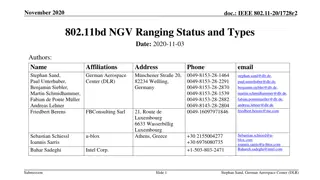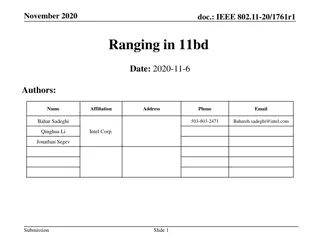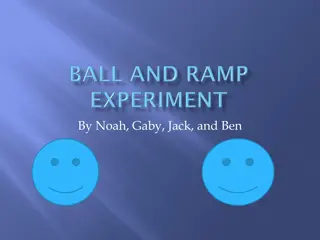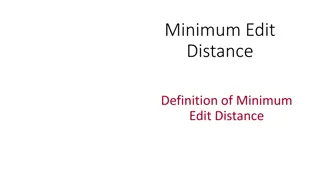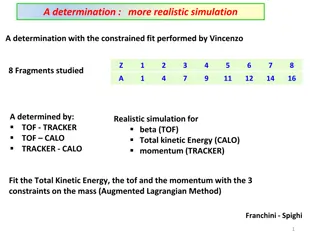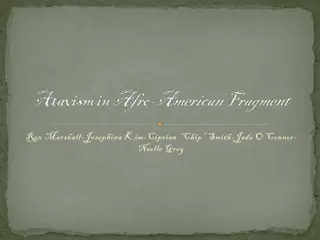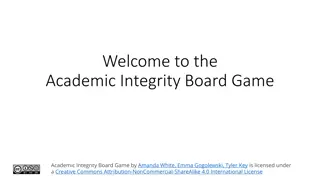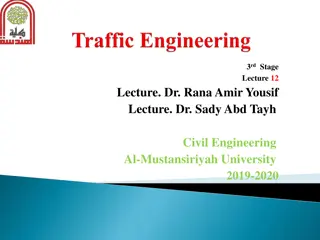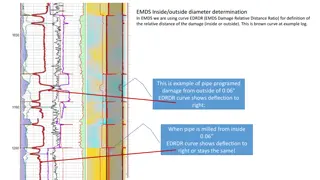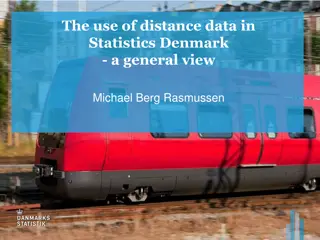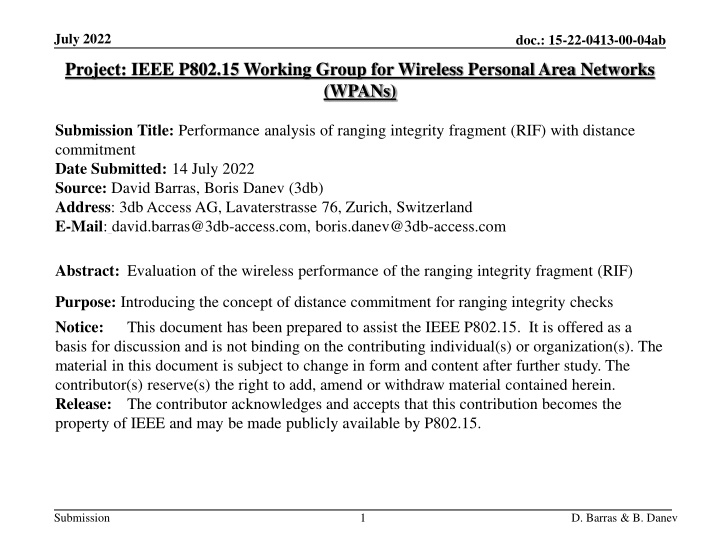
Performance Analysis of Ranging Integrity Fragment with Distance Commitment
This document presents an evaluation of the wireless performance of the ranging integrity fragment (RIF) and introduces the concept of distance commitment for ranging integrity checks. It discusses solutions for interference mitigation, backward compatibility, improved link budget, and various improvements in accuracy, reliability, and power consumption for high-integrity ranging. The proposed NBA-MMS solution aims to enhance link budget and secure ranging using Ranging Integrity Fragments. Additionally, it explores advancements in streaming capabilities, peer-to-peer protocols, infrastructure synchronization, and more to support a wide range of wireless networking use cases.
Download Presentation

Please find below an Image/Link to download the presentation.
The content on the website is provided AS IS for your information and personal use only. It may not be sold, licensed, or shared on other websites without obtaining consent from the author. If you encounter any issues during the download, it is possible that the publisher has removed the file from their server.
You are allowed to download the files provided on this website for personal or commercial use, subject to the condition that they are used lawfully. All files are the property of their respective owners.
The content on the website is provided AS IS for your information and personal use only. It may not be sold, licensed, or shared on other websites without obtaining consent from the author.
E N D
Presentation Transcript
July 2022 doc.: 15-22-0413-00-04ab Project: IEEE P802.15 Working Group for Wireless Personal Area Networks (WPANs) Submission Title: Performance analysis of ranging integrity fragment (RIF) with distance commitment Date Submitted: 14 July 2022 Source: David Barras, Boris Danev (3db) Address: 3db Access AG, Lavaterstrasse 76, Zurich, Switzerland E-Mail: david.barras@3db-access.com, boris.danev@3db-access.com Abstract: Evaluation of the wireless performance of the ranging integrity fragment (RIF) Purpose: Introducing the concept of distance commitment for ranging integrity checks Notice: This document has been prepared to assist the IEEE P802.15. It is offered as a basis for discussion and is not binding on the contributing individual(s) or organization(s). The material in this document is subject to change in form and content after further study. The contributor(s) reserve(s) the right to add, amend or withdraw material contained herein. Release: The contributor acknowledges and accepts that this contribution becomes the property of IEEE and may be made publicly available by P802.15. Submission 1 D. Barras & B. Danev
July 2022 doc.: 15-22-0413-00-04ab Performance analysis of Ranging Integrity Fragments (RIF) Submission 2 D. Barras & B. Danev
July 2022 doc.: 15-22-0413-00-04ab PAR Objective Safeguards so that the high throughput data use cases will not cause significant disruption to low duty-cycle ranging use cases Interference mitigation techniques to support higher density and higher traffic use cases Other coexistence improvement Backward compatibility with enhanced ranging capable devices (ERDEVs) Improved link budget and/or reduced air-time Proposed Solution (how addressed) NBA-MMS to improve link budget and provide secure ranging by means of Ranging Integrity Fragments (RIF) Additional channels and operating frequencies Improvements to accuracy / precision / reliability and interoperability for high-integrity ranging Reduced complexity and power consumption Quantifiable integrity levels that are not channel-dependent to allow interoperability distance commitment approach on challenge/response messages, real time and reduced post-processing Exploit tightly coupled concurrent operation of NB for secure ranging Hybrid operation with narrowband signaling to assist UWB Enhanced native discovery and connection setup mechanisms Sensing capabilities to support presence detection and environment mapping Low-power low-latency streaming Higher data-rate streaming allowing at least 50 Mbit/s of throughput Support for peer-to-peer, peer-to-multi-peer, and station-to- infrastructure protocols Infrastructure synchronization mechanisms Submission 2 D. Barras & B. Danev
July 2022 doc.: 15-22-0413-00-04ab References [0262] 15-22-0262-01-04ab-nba-uwb-technical-framework-proposal [0074] 15-22-0074-00-04ab-link-budget-analysis-for-nba-mms [0076] 15-22-0076-00-04ab-extending-nbuwb-for-secure-ranging [0392] 15-22-0392-00-04ab-more-on-mixed-mms-for-ranging-integrity [4z-2020] IEEE Std 802.15.4z 2020 [CM4a] Ieee802 15 4a Channel Model Matlab Code Ver 9, TG4a, DCN 114 Submission 4 D. Barras & B. Danev
July 2022 doc.: 15-22-0413-00-04ab Introduction (1/2) Motivation is to propose a scheme that provides a PHY for ranging integrity with high link budget ( 100 dB) whose integrity level can be quantified (for device interoperability) that can be processed real-time with the lowest possible power consumption based on the NBA-MMS foundations proposed in [0262] Proposal for ranging integrity for 4ab was presented in [0076] From [0392] renamed UWB SEC into RIF = Ranging Integrity Fragment 1ms (X-2) ms (1+Z) ms 1ms (Y-2) ms Ranging Integrity Fragment 1 Ranging Integrity Fragment 2 Ranging Integrity Fragment Y Preamble Fragment 1 Preamble Fragment 2 Preamble Fragment X Narrow band NB NB UWB UWB Source: More on Mixed MMS for Ranging Integrity (X. Luo et al) TG4ab DCN 0392 Submission Slide 5 D. Barras & B. Danev
July 2022 doc.: 15-22-0413-00-04ab Introduction (2/2) Proposal for RIF The scheme is based on exchange of challenge/response messages with distance commitment 10.3.2 in [4z-2020] It consists in checking the challenges/responses RIF messages by applying a bit error tolerance according to the security level 6.9.8.2.2 in [4z-2020] The challenges/responses RIF messages consists of bursts of UWB pulses carrying a bit of information:a burst may consist in 1 pulse (as 4z STS) or many pulses (similar to legacy HRP payload) Submission Slide 6 X. Luo, et al
July 2022 doc.: 15-22-0413-00-04ab Security Guarantees from Distance Commitment Distance Commitment is quantifying the integrity level by two parameters: Security level in bits (hardness assumption) Fixing the probability of guessing the random challenge/response message Time aperture in [nano]seconds Defining the maximum distance decrease in case of a correct guess of the random challenge/response message (Tint,RF) Submission Slide 7 D. Barras & B. Danev
July 2022 doc.: 15-22-0413-00-04ab More on the Distance Commitment Principle Distance Commitment consists in 1. measuring the time-of-arrival (ToA) during UWB PRE fragment by retrieving channel information using optimized sequences (such as Ipatov or other) 2. verify the incoming data of a challenge/response message distance commitment requires that the message is checked at the 1stpath s ToA a time aperture Tint,RF after the 1st path is allowed for collecting more energy/paths Tint,RF is trading off max. theoretical distance reduction against communication performances time aperture for late paths (here Tint,RF=10ns, starting from 1st path) first path (ToA) paths found during UWB PRE fragment Submission Slide 8 D. Barras & B. Danev
July 2022 doc.: 15-22-0413-00-04ab Security Guarantees from Distance Commitment From equation SecLev(L,k) the security level is quantifiable : the maximum number of errors (markers) is given as a function of the challenge size in number of bits (x-axis) for different security levels (20, 32, 64, 128 and 256 bits) this requirement corresponds to an equivalent maximum BER in the RIF message markers : for an increase of the security level by a factor 2 (32 to 64 bits), with same number of bits, the sensitivity reduction is 3.3 dB (more Eb/No) Link budget reduces by 3.3 dB Submission Slide 9 D. Barras & B. Danev
July 2022 doc.: 15-22-0413-00-04ab Security Guarantees from Distance Commitment markers : sending twice the number of bits over 2 fragments results in 3.1 dB incremental link budget (1+Z) ms (1+Z) ms 1ms Ranging Integrity Fragment 1 Ranging Integrity Fragment 1 Ranging Integrity Fragment 2 Preamble Fragment X Preamble Fragment X 2048 bits / <882 errors 4096 bits / <1848 errors Submission Slide 10 D. Barras & B. Danev
July 2022 doc.: 15-22-0413-00-04ab Sensitivity of Ranging Integrity Fragment Sensitivity performances of a single RIF message using distance commitment Fixed security level of 32 bits Pulses are grouped in bursts of 1 or 4 pulses burst repetition frequency: BRF = PRF/[1 or 4] Same mean PRF = 62.4 MHz Same number of pulses used for each RIF format Clock offset (that introduces CFO/SFO) is also known (has been extracted from NB fragment) and fixed to 0 ppm in the following performance simulations Submission Slide 11 D. Barras & B. Danev
July 2022 doc.: 15-22-0413-00-04ab Results in AWGN Comparison of sensitivity between UWB PRE fragment and RIF in AWGN 32-bit equivalent security level (e. g. 2048 bits / <882 errors) PRE has a 6 dB better sensitivity: PRX,1RIF - PRX,1PRE = PRX = 6 dB to balance PRE and RIF in AWGN a 1:4 ratio is needed for #PRE:#RIF (RIF is the bottleneck due to security hardness requirement and the unique path) PRX|AWGN=6dB Link budget for 32-bit secure ranging reaches 100 dB (assuming 12 dB implementation losses and PTX = -7.5 dBm) Submission Slide 12 D. Barras & B. Danev
July 2022 doc.: 15-22-0413-00-04ab Results in CM Comparison between PRE fragment and RIF under NLOS channels Channel assumptions NLOS channels from ref. [CM4a] Channel State Information (CSI) is obtained from the UWB preamble fragment of the NBA-MMS message and is considered perfect Receiver model Criteria for a successful PRE in NLOS CM: PRE shall give a valid position of the early path (compared to the early path in noiseless conditions) The window aperture duration Tint,RF is set according to the burst duration, i.e. 4ns,16ns same total window duration for all cases (fair comparison from the point of view of communication performances) Matched filter over window aperture Tint,RF Tint,RF = 4ns Tint,RF = 16ns Submission Slide 13 D. Barras & B. Danev
July 2022 doc.: 15-22-0413-00-04ab Results in CM Comparison between PRE fragment and RIF under NLOS channels Median PRE and RIF sensitivity values are similar; however, PRE has a wider spread and may becomes the bottleneck of the MMS frame Bursts of 4 pulses exhibits: - better median sensitivity, but max. mean PSD almost cancel this advantage - significantly smaller spread improvement of worst cases by > 10 dB! CM2 (residential NLOS) CM4 (office NLOS) Submission Slide 14 D. Barras & B. Danev
July 2022 doc.: 15-22-0413-00-04ab Summary & Conclusions The analysis of the sensitivity performance of the RIF under challenge/response distance commitment has been performed We considered the RIF with a burst of 1 and 4 pulses, while showing same median sensitivity, a 4 pulses per burst significantly improve the worst cases performance under NLOS by > 10 dB MMS scheme allows to optimally balance the receiver performances for the PRE and the RIF fragment for any targeted security level Outlook perform analysis on other CM (body TG6) and other RIF burst formats and BRF Submission Slide 15 D. Barras & B. Danev

